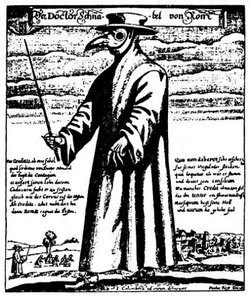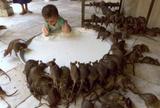The Black Death: Bubonic Plague

In the early 1330s an outbreak of deadly bubonic plague occurred in China. The bubonic plague mainly affects rodents, but fleas can transmit the disease to people. Once people are infected, they infect others very rapidly. Plague causes fever and a painful swelling of the lymph glands called buboes, which is how it gets its name. The disease also causes spots on the skin that are red at first and then turn black.
Since China was one of the busiest of the world's trading nations, it was only a matter of time before the outbreak of plague in China spread to western Asia and Europe. In October of 1347, several Italian merchant ships returned from a trip to the Black Sea, one of the key links in trade with China. When the ships docked in Sicily, many of those on board were already dying of plague. Within days the disease spread to the city and the surrounding countryside. An eyewitness tells what happened:
bubonic plague"Realizing what a deadly disaster had come to them, the people quickly drove the Italians from their city. But the disease remained, and soon death was everywhere. Fathers abandoned their sick sons. Lawyers refused to come and make out wills for the dying. Friars and nuns were left to care for the sick, and monasteries and convents were soon deserted, as they were stricken, too. Bodies were left in empty houses, and there was no one to give them a Christian burial."
The disease struck and killed people with terrible speed. The Italian writer Boccaccio said its victims often
"ate lunch with their friends and dinner with their ancestors in paradise."
By the following August, the plague had spread as far north as England, where people called it "The Black Death" because of the black spots it produced on the skin. A terrible killer was loose across Europe, and Medieval medicine had nothing to combat it.
In winter the disease seemed to disappear, but only because fleas--which were now helping to carry it from person to person--are dormant then. Each spring, the plague attacked again, killing new victims. After five years 25 million people were dead--one-third of Europe's people.
Even when the worst was over, smaller outbreaks continued, not just for years, but for centuries. The survivors lived in constant fear of the plague's return, and the disease did not disappear until the 1600s.
Medieval society never recovered from the results of the plague. So many people had died that there were serious labor shortages all over Europe. This led workers to demand higher wages, but landlords refused those demands. By the end of the 1300s peasant revolts broke out in England, France, Belgium and Italy.
The disease took its toll on the church as well. People throughout Christendom had prayed devoutly for deliverance from the plague. Why hadn't those prayers been answered? A new period of political turmoil and philosophical questioning lay ahead.
Black Death - Disaster Strikes
25 million people died in just under five years between 1347 and 1352. Estimated population of Europe from 1000 to 1352.
* 1000 38 million
* 1100 48 million
* 1200 59 million
* 1300 70 million
* 1347 75 million
* 1352 50 million

In the early 1330s an outbreak of deadly bubonic plague occurred in China. The bubonic plague mainly affects rodents, but fleas can transmit the disease to people. Once people are infected, they infect others very rapidly. Plague causes fever and a painful swelling of the lymph glands called buboes, which is how it gets its name. The disease also causes spots on the skin that are red at first and then turn black.
Since China was one of the busiest of the world's trading nations, it was only a matter of time before the outbreak of plague in China spread to western Asia and Europe. In October of 1347, several Italian merchant ships returned from a trip to the Black Sea, one of the key links in trade with China. When the ships docked in Sicily, many of those on board were already dying of plague. Within days the disease spread to the city and the surrounding countryside. An eyewitness tells what happened:
bubonic plague"Realizing what a deadly disaster had come to them, the people quickly drove the Italians from their city. But the disease remained, and soon death was everywhere. Fathers abandoned their sick sons. Lawyers refused to come and make out wills for the dying. Friars and nuns were left to care for the sick, and monasteries and convents were soon deserted, as they were stricken, too. Bodies were left in empty houses, and there was no one to give them a Christian burial."
The disease struck and killed people with terrible speed. The Italian writer Boccaccio said its victims often
"ate lunch with their friends and dinner with their ancestors in paradise."
By the following August, the plague had spread as far north as England, where people called it "The Black Death" because of the black spots it produced on the skin. A terrible killer was loose across Europe, and Medieval medicine had nothing to combat it.
In winter the disease seemed to disappear, but only because fleas--which were now helping to carry it from person to person--are dormant then. Each spring, the plague attacked again, killing new victims. After five years 25 million people were dead--one-third of Europe's people.
Even when the worst was over, smaller outbreaks continued, not just for years, but for centuries. The survivors lived in constant fear of the plague's return, and the disease did not disappear until the 1600s.
Medieval society never recovered from the results of the plague. So many people had died that there were serious labor shortages all over Europe. This led workers to demand higher wages, but landlords refused those demands. By the end of the 1300s peasant revolts broke out in England, France, Belgium and Italy.
The disease took its toll on the church as well. People throughout Christendom had prayed devoutly for deliverance from the plague. Why hadn't those prayers been answered? A new period of political turmoil and philosophical questioning lay ahead.
Black Death - Disaster Strikes
25 million people died in just under five years between 1347 and 1352. Estimated population of Europe from 1000 to 1352.
* 1000 38 million
* 1100 48 million
* 1200 59 million
* 1300 70 million
* 1347 75 million
* 1352 50 million






